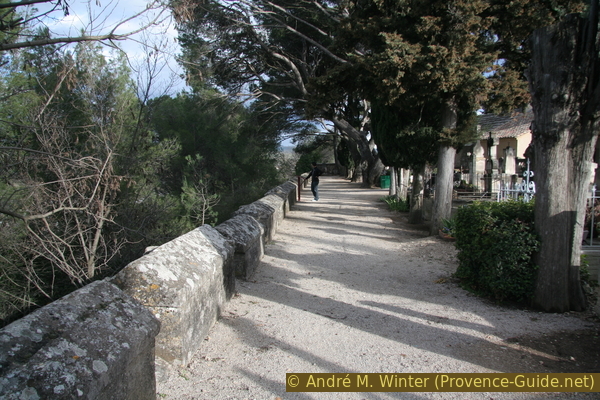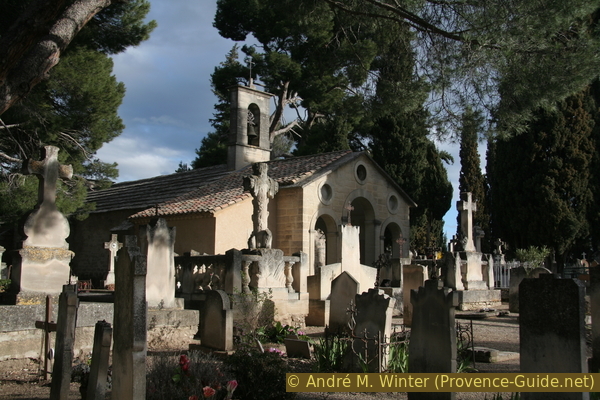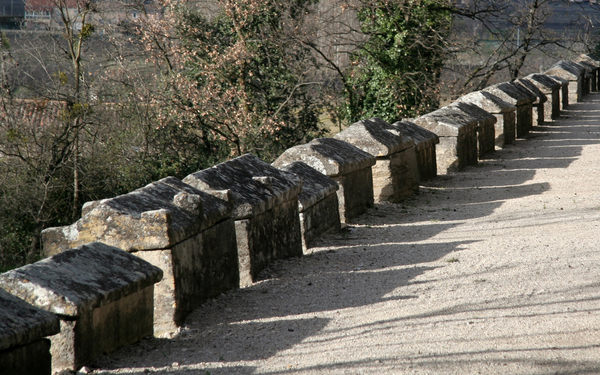Alyscamps at Mazan Cemetery
Historical and cultural site
20 min
chapel
The cemetery of Mazan, on a plateau north-east of the city, has a peculiar crowning of the retaining wall. Stone sarcophagi were lined up here, strongly reminiscent of the Alyscamps of Arles. Here, however, you do not have to pay an entrance fee, there are no crowds of tourists and the nearby old town is also worth a visit.
The 62 early Christian sarcophagi all consist of a lower basin and a cover, both carved from a solid limestone. The outer length never exceeds 180cm. The lids all have a flat roof, the only differences are the decorative edges of the lid. The acroteria can be rounded, angular, perforated or richly decorated. There are some other engraved signs, but long exposure to the open air has already eroded many of them.
No reproduction is permitted without the written consent of the author. (id2311)

Alyscamps in Mazan
Site history
The stone coffins are quite uniform and date from the 5th and 6th centuries CE. They were all made from local limestone. Much more is not known about these sarcophagi, one does not even know exactly where they come from.
On the one hand, it was common for the Romans and the successor societies to bury the dead along important connecting roads. The coffins can thus come from the Chemin Mercadier between Carpentras and Mormoiron. They could also come from a necropolis found between the center and the quarry to the southeast. Another possibility would be that the stone sarcophagi were always in the area of the current cemetery, Roman urns were also excavated here.
From the 18th century, surviving parish documents confirm that there was a debate about placing the coffins in the cemetery. But they don't say where they came from. They were placed in 1858 as we find them today.
No reproduction is permitted without the written consent of the author. (id2309)

Notre-Dame de Pareloup chapel in Mazan
The cemetery chapel
In the cemetery area we also find the Notre-Dame de Pareloup chapel. Although it looks fairly new from the outside, the main masonry dates back to the 11th century. The foundation is much older. In the centuries that followed, changes and additions were made again and again. Today's crouched form goes back to the fact that for centuries the excavation of the graves was piled up around the church.
No reproduction is permitted without the written consent of the author. (id2310)

Empty Notre-Dame de Pareloup chapel
Access by public transport
Mazan has below-average connections to the surrounding larger towns. The bus line 912 runs from Carpentras to Sault via Mazan. Information under Zou! (only french).
The stops for the cemetery are north and north-east of the center. Coming from Carpentras, stop at Place du 8 Mai. For the opposite direction, the bus stop is in front of the post office (la Poste). The cemetery can be reached on foot in a few minutes, see the text below and the map on this page.
Place du 8 Mai is a bit confusing. If we step behind the bus stop house, we see a steeply rising street behind a ramp, this is the Montée de la Madeleine. Behind the first houses, a sign with the inscription Sarcophages Gallo-Romains points our further way to the left.
Access by car
Mazan is a town on the plains to the east of Carpentras and is well-connected from most surrounding towns. The town center is surrounded by a ring road, but the main axis runs through to the north. Coming from Carpentras, take the D942 provincial road to Mazan and continue towards Mormoiron.
Parking site
When the road curves to the right around the town centre, you will see an arrow on the left pointing to the Place du 8 Mai car park. To get to the cemetery, follow the directions above.
No reproduction is permitted without the written consent of the author. (id2312)

Stone sarcophagi in Mazan